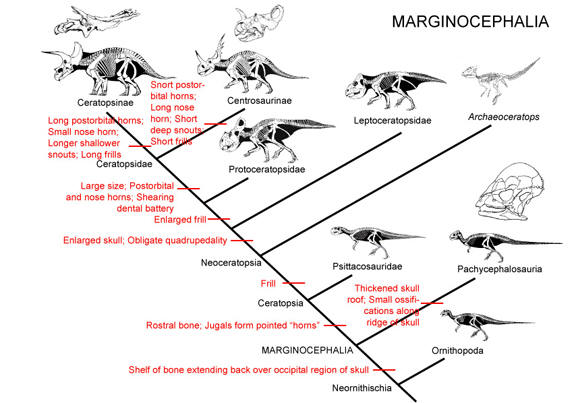|
|
|
Marginocephalia |
|
The Marginocephalia ("fringed heads") are a clade of extinct
herbivorous dinosaurs that inherited a slight shelf or frill at the
back of their skull from their common ancestor back in the Early/mid
Cretaceous period. This "margin" was elaborated differently in the two
main subgroups of the Marginocephalia. You are probably familiar with
some of these taxa — they include the "bone-headed"
pachycephalosaurs and the frilled
Ceratopsians, such as the early Protoceratops and the
famous Triceratops (pictured above).
Marginocephalians (meaning "fringed heads") are a group of
Ornithischian (bird-hipped) dinosaurs that have a distinctive
skull structure (a slight shelf or bony frill on the back of the
skull), a unique palate (part of the mouth) and a short
pubis (part of the hip).
These plant-eaters include the Ceratopsians (horned dinosaurs like
Triceratops,
Styracosaurus, Pentaceratops,
Protoceratops, etc.) and the Pachycephalosaurians (thick-skulled
dinosaurs like ,
Pachycephalosaurus, etc.).
Marginocephalians may have evolved from the closely-related
Ornithopods. |
|
Name means "ridge head"
Characterized by shelf of bone extending back over occipital
region of skull
Absent from fossil record until Early Cretaceous
Primitive forms are bipedal; in one branch derived forms become
very large and obligate quadrupeds
Marginocephalian skulls show a lot of suggestions of display
and/or combat
Some paleontologists have suggested that the ?Late Triassic
through Late Jurassic Heterodontosauridae were more closely related to
marginocephalians than to true ornithopods. If so, these would be the
oldest members of this lineage.
Except for a few fragmentary specimens, all marginocephalians known
fall into one or the other of two clades: the thick-skulled
Pachycephalosauria or the deep-beaked (and often frilled (and
sometimes horned)) Ceratopsia.
|
|
Pachycephalosaurs:
- Sometimes called boneheads or domeheads or
buttheads
- Except for a possible Early Cretaceous form from Europe, are
known only from the Late Cretaceous of Asia and western North
America
- Obligate bipeds
- Postcranially resemble heavy hypsilophodonts
- Most obvious derived feature: thickened bone on skull roof
- In primitive forms, the skull is still relatively flat
- In advanced forms, this thickened roof forms a dome
- Suggested behavior uses for these domes:
- Used to butt theropod legs and bellies as defense
- Used like the horns of bighorn sheep in dominance fights for
females or territory
- Some indication of sexual dimorphism, with bigger domed
males and smaller domed females
- Pachycephalosaurs also have rows of small dermal
ossifications around back of skull
- Some indication of strengthened cervical and dorsal vertebrae
(for absorbing impacts?)
- Most were smaller than humans; only last and largest (Pachycephalosaurus)
was bigger than a human
- Relatively unsophisticated jaws and teeth
- Relatively rare, seem to have preferred drier environments
|
The other main branch of the marginocephalians are the ceratopsians:
- Oldest known ceratopsians are from the Early Cretaceous of Asia
(Chaoyangosaurus, Liaoceratops, and especially the
Psittacosauridae or "parrot dinosaurs")
- Early marginocephalians were bipeds (possibly facultative
bipeds), with bodies like heavily build hypsilophodonts
- Synapomorphies of Ceratopsia:
- Rostral bone, a bone unique to Ceratopsia
- A single, non-paired bone
- Attached in front of the premaxillae (and so it is a
pre-premaxilla!)
- Forms the upper part of the beak, mirror image of the
predentary
- Jugals form pointed "cheek bones"
- Ceratopsians have very deep and powerful jaws, with strong
shearing bite
At the end of the Early Cretaceous, the first of the more advanced Neoceratopsia appears:
- Neoceratopsians characterized by a frill
- Frill formed by extensions of the parietal and squamosal
- Served in part as increased surface attachement for jaw
muscles
- Very likely was also used as a visual display
- Neoceratopsians also have enlarged heads (that is, their
heads are 20% or more the length of the postcranium)
- Early neoceratopsian, such as late Early Cretaceous
Archaeoceratops were still bipedal
- More advanced neoceratopsians had larger frills and heads,
forcing them to become obligate quadrupeds
- Protoceratopsids of the Late Cretaceous of Mongolia and
leptoceratopsids of the Late Cretaceous of Asia and western North
America represent this grade of neoceratopsians.
Some neoceratopsians developed postorbital horns (one over
each eye) and nasal horns. These are the Ceratopsidae.
All known ceratopsids are from western North America; all are from the
later part of the Late Cretaceous.
Ceratopsids also have a shearing dental battery of teeth,
with a continuous cutting surface. Coupled with their powerful jaw
muscles, they probably had an extremely powerful shearing bite for
dealing with tough plants.
Ceratopsids are larger than most "protoceratopsian"-grade
neoceratopsians .
Ceratopsids are divided into two clades:
- Centrosaurinae, with smaller postorbital horns,
long nose horns, short deep snouts in front of the orbit.
- Ceratopsinae (sometimes called Chasmosaurinae),
with longer postorbital horns, smaller nose horns,
long shallow snouts, and generally longer frills
- Triceratops of the latest Cretaceous of western
North America is a ceratopsine
Both ceratopsid clades contained species that lived in herds.
Where known, juvenile centrosaurines of all species resemble each
other, and only develop their autapomorphic features when nearly fully
grown. (This may be true for ceratopsines, but they are not known from
many juvenile specimens yet).
Ceratopsine postorbital horns sometimes show wear or breakage
halfway down their length, and there are puncture marks on some
frills. Their horns may have been used for within-species combat for
dominance.
|
 |
| |
|